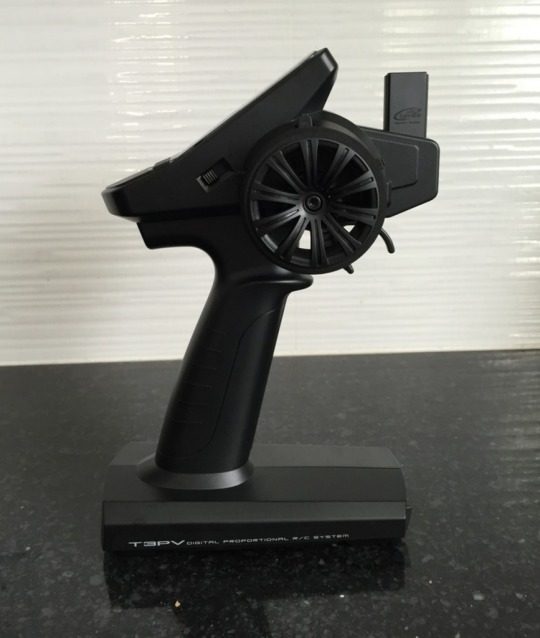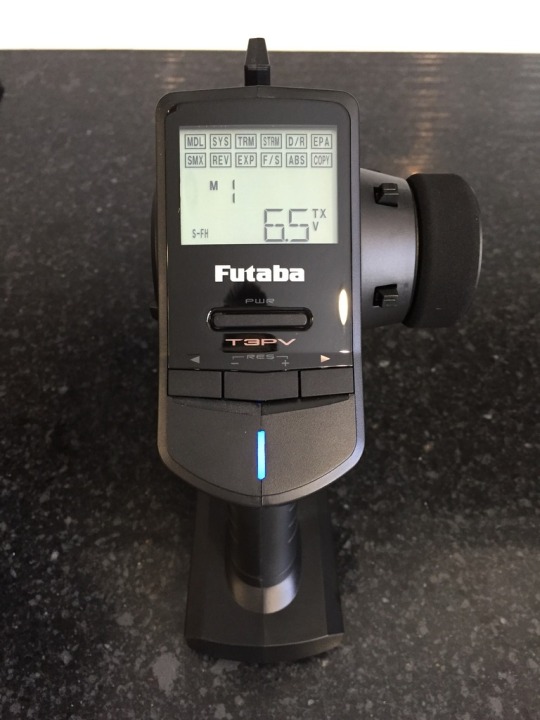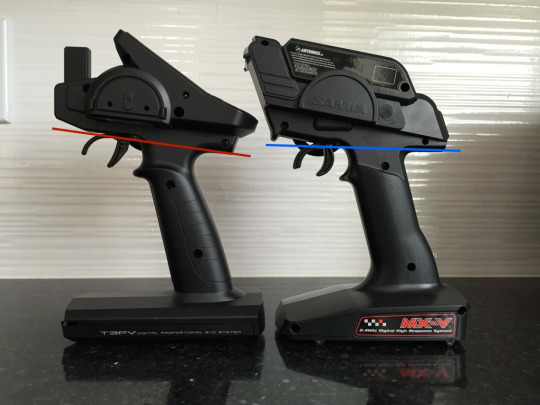
My Futaba 3PV came in! Tower was having a good deal on this radio, so I picked one up and decided to do an update on the Futaba 3PL vs. Sanwa MX-V comparison. That’ll come later, but first up is the review of the Futaba 3PV!
Scores in the following categories are rated from 1-10, with 5 being what I consider average in the class, and 10 being perfect.
Overview:
The 3PV is the new replacement for the venerable 3PL. The 3PL was getting a little long in the tooth, and had run its course. It had a few shortcomings, namely the menu system sucked and there was no expo control. It also looked (and felt!) like you were holding Thor’s hammer…
The 3PV looks to rectify those shortcomings – at first glance, it’s a pretty stylish controller, has all of the right features, and is priced similarly to the 3PL at $109.99.
Now, this radio is sometimes referred to as the 3PV and sometimes it’s called the T3PV. They’re the same radio, and it’s a little weird because the print on the radio says T3PV and the manual says 3PV. If you look online at Futaba’s website and other places, it’s referred to by both names. I’m not sure if they changed their mind on the name halfway through or what, but I’ll be calling it the 3PV in this review.
Features: 8
The radio has all the main adjustments you would expect from a good entry-level transmitter: trim and sub-trim, steering and throttle EPA, dual-rate, and… (an upgrade from the 3PL) expo! That was really my only gripe with the 3PL, you couldn’t adjust steering or throttle expo. It also has an LCD display, internal antenna, 4 channels with 4WD/mixing and ABS. Pretty much like the 3PL, but the LCD is much larger and centrally placed. The radio supports 4 channels, but the 3rd channel is switched only, and the 4th channel can only be used in 4WS mode in conjunction with the steering channel.
This feature set is pretty standard for this category of radios, but it does have something unusual: telemetry.
Well, not full telemetry – what the 3PV supports is receiver voltage (if you pay extra for the R304SB receiver version) and battery voltage (if you buy the $50 external sensor). Receiver voltage isn’t that useful for electric vehicles, but could be useful for nitro.
I use battery voltage on my Sanwa MT-S and MT-4S and find it incredibly helpful. At $50 for the sensor and $50 per receiver, it’s a bit pricey to do the same with this system. So it’s not quite the full telemetry you get with the high-end systems, and it’s a little pricey to even get battery voltage. I expect most owners aren’t going to use voltage telemetry, but it’s there and certainly an added bonus.
Design: 8
What’s not readily apparent in the pictures is that this radio is tiny. It’s elegant. I’d call it petite, even. It actually feels more like a 7/8th scale radio to every other radio in it’s class. If I still had my 3PL, putting it side-by-side would be hilarious, as it is so much smaller.
I personally found it disconcertingly small at first, as I’ve never used a radio this small before, and I honestly felt a little uncomfortable walking around with such a small radio. If you have size-compensation issues, this is not going to be the right radio for you…
But over time, I got used to it and started to like the small size, and…
…it’s also insanely light! I weighed it at 262 grams (without the AA battery tray). It’s gotta be the lightest radio in it’s class, by far, and is probably lighter than a lot of RTR radios.
The design is quite elegant, it has kind of a 4PX profile, but on a smaller scale. It has a nice, fairly large easy-to-read LCD display.

At the top is a row of menu items that you can scroll through using the left and right arrow buttons. The +/- buttons adjust the item you’re on.
Controls: 4
The handle is quite angled, compared to the Sanwas which uses a more upright handle. It’s also quite thin, and fits small hands well. The wheel is nice with a fairly light amount of tension, and has a very linear rate. It measures at 51mm across, which is the perfect size to me and not humongous like the Spektrums.
One nice detail on the wheel is that the foam sits in a grooved channel unlike the 3PL. This prevents the foam from sliding around left and right, which can be a problem on most radios. I ended up gluing the foam down on the 3PL, but this nice design improvement will avoid that necessity. Well done Futaba!
The trigger had a tiny bit of play, but the thing I noticed immediately (and did not like) is that there is an upward angle between the handle and the trigger. In other words, the trigger sits a little higher than your hand, which means your finger has to sweep upward a little bit to reach the trigger.
This was kind of weird, and coupled with an angled handle meant that my trigger finger had to extend extra far and upward to brake. Here you can see the upward sweep from grip to trigger in red, as compared to the MX-V in blue. You can also see the more swept back grip.
If you’re familiar with fireams, the 3PV has more of an M-16 style grip, whereas the MX-V has more of a .45 Colt grip.

It doesn’t look like much, but trust me, you can feel it when using this radio. I have short fingers, so this actually made it difficult to use the full length of the brake. With long fingers, this is probably not as much of an issue.
Another thing is the trigger also goes all the way up flush with the underside of the transmitter at full brake, which means your finger tends to hit the underside of the transmitter. I found this annoying and intrusive.

Trigger hole size is average sized: I measured it at 17.1mm in diameter, which was a little big for my finger, but nothing untoward. Trigger pull was measured at 14mm for throttle, and 6mm for brake, for a standard 70:30 ratio. But the brake feels longer than that, as explained above.
Overall, the radio has a nice wheel, but the handle and trigger are not quite ergonomically correct in my opinion. I have to give it lower marks for this reason.
Construction: 7
The plastics on the 3PV are nice and smooth, construction is solid, and there are no abnormal gaps are seams. The plastics seem a little thinner and lighter than what I remember on the 3PL – that transmitter was a beast of a radio, and I dropped it many times and it took it like a champ.
The 3PV is probably not as robust as the 3PL. The 3PL was a tank, and weighed like one too.
There is about a mm of play laterally on the trigger. I didn’t notice it when driving, but it’s there.
Performance: 7
The radio feels pretty responsive to me, I did not notice any abnormal delays or lag. I ran it in S-FHSS mode, which might be faster than standard FHSS, I’m not really sure, but it felt natural and quick. I’m sure it’s not as quick as some of the high-end models, but for club racing I don’t think you’ll have any issues. I’ll have to set it up in my 2WD stock buggy to get a better feel, but so far it seems fine.
Menu: 4
The menu system is fine – it shows you which adjustment you’re on, and you can cycle through them left and right. But there’s one annoying thing about the system, there are 27 friggin’ items you have to cycle through to get back to the first one in the list! I mean, that’s kind of crazy – fortunately you can go forward or backward in the list (the 3PL could only go forward), and you can go back to the battery main display by holding down a left/right button. But that’s just too many selections for one menu, and it would’ve been nice if they had sub-menus or some other way to drill down rather have to cycle through all 27 of them. For sheer annoyance factor alone, I have to give it a below-average score.
Binding: 7
Binding is super simple and couldn’t be easier. You just turn everything on and press the bind button. That’s it! It supports 10 model memory, and model copy, which is a useful feature.
But something I noticed with Futaba radios that is different than some others, is that the receiver binds to the radio, but there is no model matching. In other words, you could have a profile for your buggy, and one for your truck, but the receiver in your buggy is just going to bind to your radio. If you switch your radio to the truck settings, it will still work with the buggy and it won’t know you’re driving in the wrong profile. So you can accidentally be driving around in the wrong profile and not know it.
This is different than some other systems, where you HAVE to be in the truck setting and have your truck on to control it. If you’re in the buggy profile, and turn your truck on, you can’t drive it until you switch to the buggy profile.
Battery: 8
The 3PV comes with a battery tray for 4 AA batteries, but you can remove that and plug in a LiPo or LiFe battery. You can also buy a Futaba NiMh battery and use the integrated DC jack to charge the NiMh directly through the radio. Lots of battery options!
I ran it with a LiFe stick battery which was a tight fit, you’ll want to get a more square battery if you go that route.
The 3PV shows you the battery voltage in nice big numbers on the display, so you’ll always know when it’s time to charge. There is also an automatic power-off after 10 minutes of inactivity. Handy little feature so you don’t accidentally drain your battery.
Manual: 9
The 3PV manual is complete and comprehensive and comes with a nice glossy cover and is printed on quality paper. I didn’t find any errors, and it’s reasonably easy to read and refer to. Yes, I did actually read the manual cover to cover! (OK, I admit I skipped the warnings section).
Price: 5
The Futaba retails for $109.99 at the time of this post. With coupons and discounts, I was able to get it for $96 - $10 rebate shipped, which is not overly expensive. It’s not as cheap as the Chinese radios, but you kind of get what you pay for with those. I’d say price-wise, this radio is middle-of-the-road.
Conclusion: 8
The Futaba 3PV is a good, much improved radio over its predecessor, the 3PL. In this price range and class, it is one of the top radios on the market today.
Areas where it scores high marks are its elegant design, amazing light weight, big display, full set of features (including battery telemetry), and excellent battery options. Performance seemed good, but its hard to tell without running it back to back with another radio. Speaking of which… I should have a comparison test with the Sanwa MX-V, and Flysky GT-3C in about a week.
I do have issues with the grip/trigger layout, enough that I recommend you test one out in person before buying if you can. It’s honestly annoying enough that I may decide not to keep this radio, we’ll have to see how it stacks up against the other entry-level radios. Stay tuned for an upcoming comparison review!
YouTube review:
Thank you for this. I was looking at the DX4C and then learned about FHSS vs DSMR and switched to the 3PV. This article helped. Thanks again!
ReplyDeleteAwesome, you're welcome! I'm pretty sure the Futaba has the fastest response among the 3 major brands in this price range (Futaba 3PV, Sanwa MX-V, Spektrum DX4C). You made a good choice!
ReplyDeleteI will likewise go with futaba!
ReplyDeleteI will likewise go with futaba!
ReplyDeleteAwesome! Thank you for the review!
ReplyDeleteWith your statement regarding the receivers binding to the radio, I would like some clairification please. I would like to use this system for my boats, one of which will be a recovery vehicle. Am I understanding you correctly when you say the transmitter wont dissern between the two vehicles no matter the setting on the radio? I wouldnt want my flipped boat to react to transmitter inputs I direct towards the recovery vehicle. Am I understanding you correctly? Thank you, nice write up btw.
ReplyDeleteI haven't tried it with two cars on simultaneously, but I'm 90% sure it would try to control both boats at the same time.
DeleteOk, thanks. Clearly that wont work for me.
Delete